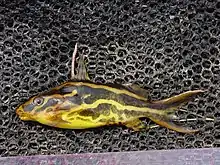Synodontis flavitaeniatus
Synodontis flavitaeniatus, known as the orangestriped squeaker,[1][2] the chocolatestriped squeaker,[1][2] the yellowstriped squeaker,[1][2] and the pyjama Syno,[2] is a species of upside-down catfish native to the Democratic Republic of the Congo and the Republic of the Congo where it is found in the lower and central Congo Basin.[3] It was first described by Belgian-British zoologist George Albert Boulenger in 1919. The holotype was collected from the Ruki River at Eala, in the Democratic Republic of the Congo.[1] The meaning of the specific name "flavitaeniatus" is "yellow stripes".[2]
| Synodontis flavitaeniatus | |
|---|---|
 | |
| Scientific classification | |
| Domain: | Eukaryota |
| Kingdom: | Animalia |
| Phylum: | Chordata |
| Class: | Actinopterygii |
| Order: | Siluriformes |
| Family: | Mochokidae |
| Genus: | Synodontis |
| Species: | S. flavitaeniatus |
| Binomial name | |
| Synodontis flavitaeniatus Boulenger, 1919 | |
Description
The body of the fish is brownish or orange-brown and is marked with yellow and dark brown horizontal bands.[2][4] The underside of the fish is a lighter brown with small irregular blotches.[4] The dorsal, pectoral, ventral, and anal fins are clear and marked with contrasting dark-colored spots.[2][4] The adipose fin is dark except for the extreme tip which is lighter. The bands in the body extend through the strongly-forked caudal fin with light patches at the edges and center.[2][4] When stressed, the brown coloration can be tinged with pink.[2] Older individuals may be yellowish-brown.[2]
Like other members of the genus, this fish has a humeral process, which is a bony spike that is attached to a hardened head cap on the fish and can be seen extending beyond the gill opening.[2] The first ray of the dorsal fin and the pectoral fins have a hardened first ray which is serrated.[2] The caudal fin is deeply forked with an extension on the top lobe.[2][4] It has short, cone-shaped teeth in the upper jaw.[2] In the lower jaw, the teeth are s-shaped and movable.[2] The fish has one pair of short maxillary barbels, and two pairs of mandibular barbels that are often branched.[2][4]
This species grows to a length of 15.5 centimetres (6.1 in) SL although specimens up to 19.5 centimetres (7.7 in) TL have been recorded in nature.[1][2]
In the wild, the species inhabits tropical waters with a temperature range of 23 to 28 °C (73 to 82 °F), a pH of 6.5 – 8.0, and dH range of 4-25.[1]
References
- Froese, Rainer; Pauly, Daniel (eds.) (2016). "Synodontis flavitaeniatus" in FishBase. June 2016 version.
- "Synodontis flavitaeniatus Boulenger, 1919". Planet Catfish. 19 Jul 2013. Retrieved 17 October 2016.
- Moelants, T. (2010). "Synodontis flavitaeniatus". The IUCN Red List of Threatened Species. IUCN. 2010: e.T182127A7809758. doi:10.2305/IUCN.UK.2010-3.RLTS.T182127A7809758.en. Retrieved 15 January 2018.
- "Synodontis flavitaeniatus Boulenger, 1919". scotcat.com. Retrieved 17 October 2016.
External links
![]() Data related to Synodontis flavitaeniatus at Wikispecies
Data related to Synodontis flavitaeniatus at Wikispecies
